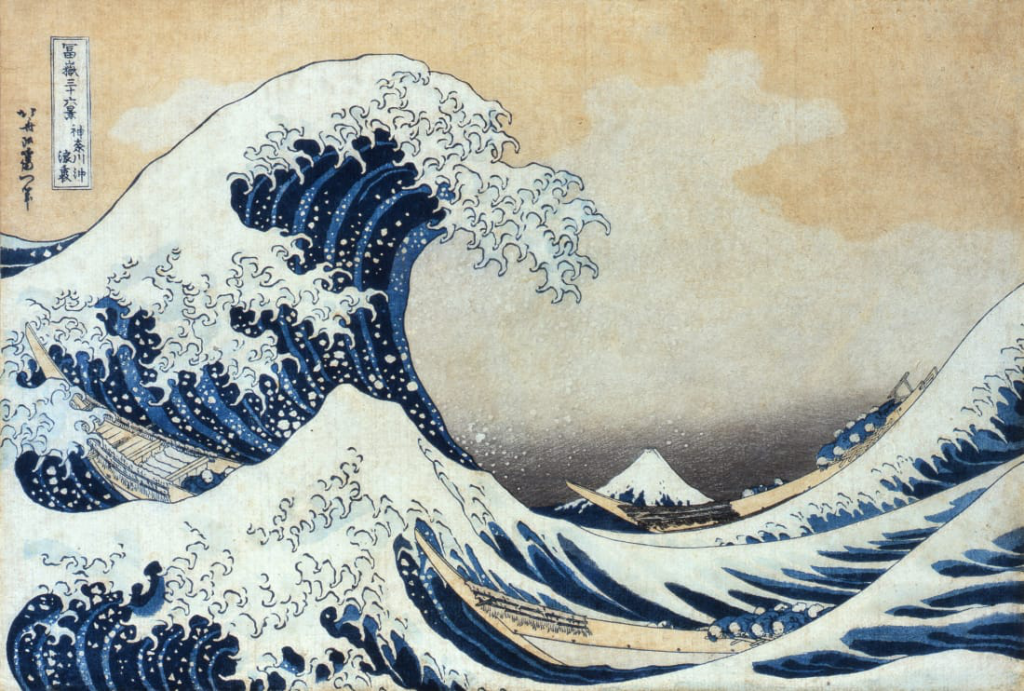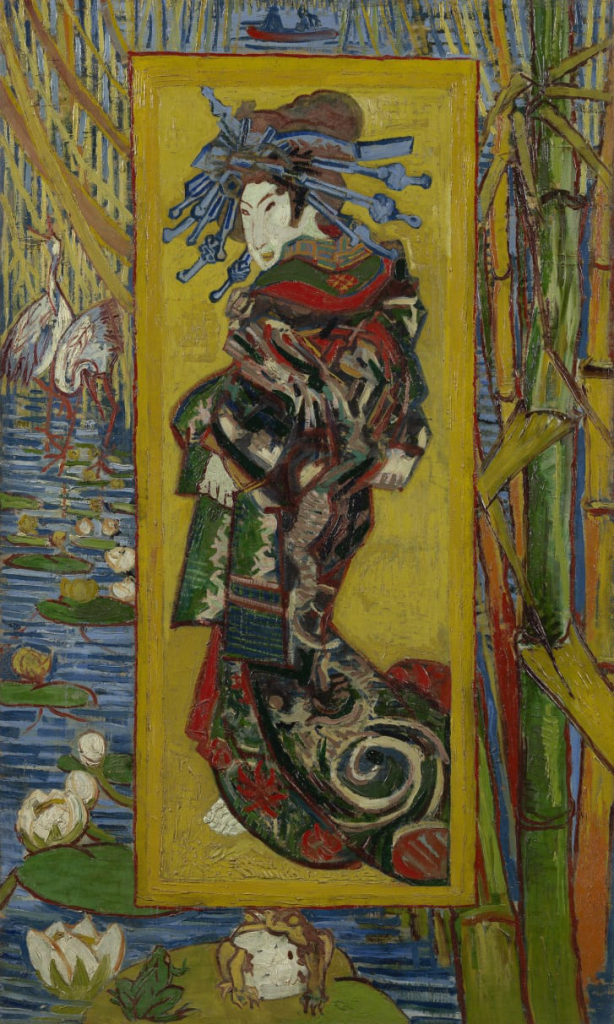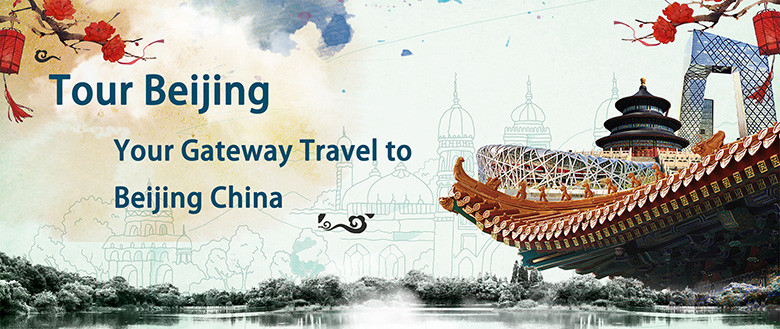Why the 'Great Wave' has mystified art lovers for generations
日本木版画:为什么“巨浪”让几代艺术爱好者迷惑不解
Written byDan Tham, CNNJunko Ogura, CNN
CNN新闻 丹·瑟姆,小仓纯子撰文

The famous kanagawa wave.Scroll through the gallery to see more of his ukiyo-e prints.hokusai
著名的《神奈川巨浪》。滚动通过画廊看到更多他的浮世绘版画。葛饰北斋
A massive wave threatens to engulf three fishing boats, its foam crown extending like claws, menacing the rowers below. It's an epic scene of human struggle and natural terror that dwarfs the sacred Mount Fuji just behind it.
This is "The Great Wave off Kanagawa," a woodblock print by the Japanese artist Katsushika Hokusai and one of the world's most iconic pieces of Asian art.
If this climactic moment seems ubiquitous -- think T-shirts, coffee mugs, laptop decals -- that's because it was designed to be.
巨浪威胁要吞没三艘渔船,它的泡沫王冠像爪子一样伸出来,威胁着下面的桨手。这是一个人类斗争和自然恐惧的史诗般的场景,使后面神圣的富士山相形见绌。
这是日本艺术家葛饰北斋(Katsushika Hokusai)的木版画《神奈川巨浪》(The Great Wave off Kanagawa),是世界上最具标志性的亚洲艺术品之一。
如果这个高潮时刻似乎无处不在——想想t恤、咖啡杯、笔记本电脑贴纸——那是因为它的设计初衷就是如此。

A visitor looks at Katsushika Hokusai's famous print, "The Great Wave off Kanagawa," at the Ara Pacis Museum in Rome.Credit: AFP Contributor/AFP/AFP/Getty Images
一位游客在罗马的阿拉·帕西斯博物馆欣赏葛饰北斋著名的版画《神奈川巨浪》。来源:法新社供稿人/法新社/法新社/盖蒂图片社
The artwork is considered a fine, if somewhat hackneyed, example of "ukiyo-e," a genre of mass-produced Japanese woodblock prints that displayed everything from theater announcements to the most salacious of erotica.
Ukiyo-e prints were cheap to produce and widely distributed in Edo (today's Tokyo) between the 17th and 19th centuries. As many as 5,000 impressions were made from the original woodblocks for "The Great Wave." Back then, the prints were sold for the price of a bowl of noodles.
这幅作品被认为是“浮世绘”(ukiyo-e)的一个很好的例子,尽管有些陈腐。浮世绘是一种大规模生产的日本木版画,展示了从剧院公告到最淫荡的情色作品的方方面面。
浮世绘版画制作成本低廉,在17世纪至19世纪期间广泛分布于江户(今天的东京)。《巨浪》的原始木刻版画多达5000幅。当时,这些版画的售价是一碗面条的价格。
By the time "The Great Wave" made its debut, in around 1830, Japan was flirting with the idea of ending more than 200 years of isolationism. The story of growing foreign influence is evident in Hokusai's masterpiece -- the rich shade of blue used in the prints was imported from Europe. Prussian blue, as it's commonly known, was a synthetic color created in the 18th century and prized for its depth and durability.
That Hokusai employed the hue as the principal actor in his oceanic drama suggests that he was depicting Japan on the cusp of change. As much as the wave portends instability and danger, it also suggests possibility and adventure.
1830年左右,《巨浪》首次亮相时,日本正在考虑结束200多年的孤立主义。在葛饰北斋的杰作中,外国影响力不断增长的故事是显而易见的——版画中使用的丰富的蓝色是从欧洲进口的。众所周知,普鲁士蓝是18世纪合成的一种颜色,因其深度和耐用性而备受赞誉。
葛饰北斋在他的海洋戏剧中使用了这种色调作为主色调,这表明他在描绘处于变革风口浪尖的日本。尽管海浪预示着不稳定和危险,它也暗示着可能性和冒险。
Essence' of Japan
日本的“精华”
Hokusai spent most of his life in the riverside district of Sumida, Tokyo, where he adopted at least 30 pseudonyms and, perhaps, just as many different styles. "The Great Wave" was the first in his series "Thirty-six Views of Mount Fuji," a virtuosic study of Japan's highest and most revered mountain.
葛饰北斋一生的大部分时间都在东京Sumida的滨江区度过,在那里他用了至少30个笔名,或许还有许多不同的笔名。《巨浪》是他的《富士山三十六景》系列的第一部, 对日本最高、最受崇敬的山峰的艺术研究。

"Umezawa Manor in Sagami Province," another print from Hokusai's collection "Thirty-six Views of Mount Fuji." Credit: Katsushika Hokusai
《相上省的梅泽庄园》(Umezawa Manor in Sagami Province),这是葛饰北斋收藏的另一幅版画《富士山36景》(36 Views of Mount Fuji)
"Many people view the painting as the very essence of Japanese culture," says Atsuko Okuda, chief curator of the Sumida Hokusai Museum in Japan. "The simple and powerful composition of the mountain and the shape of the wave strikes right at the heart of the observer."
“很多人认为这幅画是日本文化的精髓,”日本北斋住田博物馆(Sumida Hokusai Museum)馆长奥田硕子(Atsuko Okuda)说。“山的简单而有力的组成和波浪的形状正好击中了观察者的核心。
Observers famously included French Impressionists Edgar Degas and Claude Monet, as well as Dutch master Vincent van Gogh, who was enamored with"The Great Wave." They were not alone: In the 1860s, the proliferation of ukiyo-e in Europe led to an artistic fascination with Japan in the West, known as "Japonisme."
著名的观察人士包括法国印象派画家埃德加·德加(Edgar Degas)和克劳德·莫奈(Claude Monet),以及痴迷于《巨浪》(The Great Wave)的荷兰大师文森特·梵高(Vincent van Gogh)。他们并不孤单:在19世纪60年代,浮世绘(ukiyo-e)在欧洲的扩散,引发了西方对日本的艺术迷恋,被称为“日本主义”(Japonisme)。

梵高的《交际花》中大胆的色彩和轮廓显示了日本木版画的影响。资料来源:阿姆斯特丹梵高博物馆/梵高基金会
Yet, the woodblock prints weren't considered art in Japanese society during the Edo period, according to Yukiko Takahashi, the sixth-generation owner of the Takahashi Kobo publishing house.
然而,据小林高桥出版社(Takahashi Kobo publishing house)第六代老板高桥幸子(Yukiko Takahashi)说,江户时代的日本社会并不认为木版画是艺术。
"At some point, ukiyo-e was brought to foreign countries," says Takahashi, whose family has been making ukiyo-e for more than 150 years. "We Japanese didn't realize how wonderful they were, because we took them for granted in our daily lives."
“在某种程度上,浮世绘被带到了外国,”高桥说。他的家族制作浮世绘已有150多年的历史。“我们日本人没有意识到他们有多棒,因为我们在日常生活中把他们视为理所当然。”
An endangered art
At Takahashi's workshop, craftsman Noriyasu Soda works on a replica of Hokusai's "Great Wave." He first dampens the "washi" paper, before applying paint and a small amount of rice glue to the woodblock to ensure that the colors stick.
Each side of any given block represents a different color that will be layered into the ukiyo-e. This piece alone requires a black outline, various blues for the water, and shades of yellow and pink for the sky.
濒危的艺术
在高桥的工作室里,工匠Noriyasu Soda正在制作北斋“巨浪”的复制品。他先把“瓦楞纸”弄湿,然后在木版上涂上颜料和少量的米粉,以确保颜色粘在一起。
任何给定块的每一面都代表一种不同的颜色,这些颜色将被分层到ukiyo-e中。单单这幅作品就需要一个黑色的轮廓,不同的蓝色代表水,黄色和粉色代表天空。

In the earlier stages of his career,Hokusai worked on a number of illustrated books.Credit:Katsushika Hokusai
在他职业生涯的早期阶段,葛饰北斋创作了许多插图书籍。藏家:Katsushika HokusaI
The process is painstaking and demands utmost precision. Takahashi says it takes about a decade to become a true ukiyo-e "shokunin," or master craftsman, and that there are only 25 left in Tokyo today.
"We have to succeed in passing down this wonderful technique of ukiyo-e woodblock prints," she says. "The craftsmen involved in this work are trying their best to teach these skills to the next generation."
这一过程是艰苦的,要求极其精确。高桥说,要想成为一名真正的ukiyo-e“shokunin”,也就是工匠大师,需要大约十年的时间,现在东京只剩下25名工匠了。
她说:“我们必须成功地传承浮世绘木版画的这种奇妙技术。”“参与这项工作的工匠们正在尽最大努力把这些技能传授给下一代。”
TB北京中文旅游服务
北京外宾旅游
北京外宾特色旅游
北京外宾旅行指南
北京包车旅游
北京参团旅游
北京长城徒步游
北京租车服务
北京定制旅游
TB北京英文旅游服务
Beijing Tour
Great Wall Tour
Beijing Tour Packages
Beijing Day Tour
Beijing Group Tour
Beijing Winter Tour
Car Rental in Beijing
Create My Beijing Trip
TB 英语
环球旅游英语
健康生活英语
新闻英语词汇
生活英语词汇
英语文学词汇
英语咬文嚼字
英汉智慧语录
版权声明:本文为原创文章,版权归 admin 所有,欢迎分享本文,转载请保留出处!



